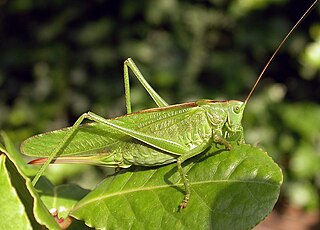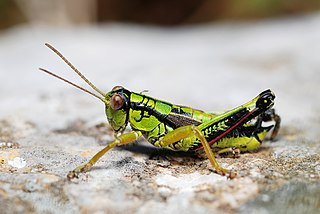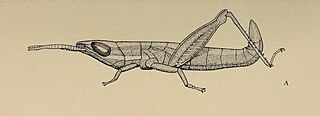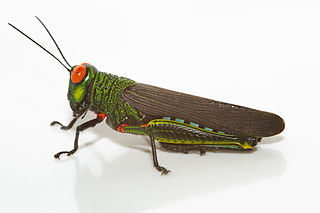
The Rocky Mountain locust is an extinct species of grasshopper that ranged through the western half of the United States and some western portions of Canada with large numbers seen until the end of the 19th century. Sightings often placed their swarms in numbers far larger than any other locust species, with one famous sighting in 1875 estimated at 198,000 square miles (510,000 km2) in size, weighing 27.5 million tons and consisting of some 12.5 trillion insects, the greatest concentration of animals ever speculatively guessed, according to Guinness World Records.

Cooloola is a genus of ensiferan orthopterans known as Cooloola monsters. It is the only genus in the subfamily Cooloolinae and family Cooloolidae of the superfamily Stenopelmatoidea.

The black-footed mongoose is a mongoose species native to Central Africa, where it inhabits deep deciduous forests from eastern Nigeria to the southern Democratic Republic of the Congo. It has been listed as Least Concern on the IUCN Red List since 2008. It is omnivorous and feeds on ants, termites, Orthoptera, small rodents, frogs, lizards and fruits. It is mostly solitary and nocturnal.

The Tettigoniinae are a subfamily of bush crickets or katydids, which contains hundreds of species in about twelve tribes.

Hemiandrus is a genus of wētā in the family Anostostomatidae. In New Zealand they are known as ground wētā due to their burrowing lifestyle. Hemiandrus wētā are nocturnal, and reside in these burrows during the day. Ground wētā seal the entrance of their burrow during the day with a soil plug or door so that their burrow is concealed. This genus was originally said to be distributed in Australia and New Zealand, however, with recent molecular genetic methods, this is under debate. Ground wētā adults are smaller than other types of wētā, with the unusual trait of having both long and short ovipositors, depending on the species. The name of this genus is said to come from this trait as hemi- mean half and -andrus means male, as the species where the female has a short ovipositor can sometimes be mistaken for a male. This genus has a diverse diet, depending on the species.
Conozoa hyalina, the California Central Valley Grasshopper or just Central Valley grasshopper, was a species of grasshopper in the family Acrididae, now extinct. It was endemic to the United States.

Deinacrida heteracantha, also known as the Little Barrier giant wētā or wētāpunga, is a wētā in the order Orthoptera and family Anostostomatidae. It is endemic to New Zealand, where it survived only on Little Barrier Island, although it has been translocated to some other predator-free island conservation areas. This very large flightless wētā mainly feeds at night, but is also active during the day, when it can be found above ground in vegetation. It has been classified as vulnerable by the IUCN due to ongoing population declines and restricted distribution.

Miramella is a small genus of short-horned grasshoppers in the subfamily Melanoplinae. They are found in Europe and eastern Asia. As of January 2019, Orthoptera Species File lists seven species in three subgenera. The genus was first named in 1932. Miramella is the type genus of the subtribe Miramellina.
Tettigidea empedonepia, the Torreya pygmy grasshopper, is a species of grasshopper in the family Tetrigidae. The type locality is Camp Torreya in Liberty County, Florida. According to Orthoptera Species File, it has also been found in Cuba.
Trimerotropis occulens, the Lompoc grasshopper, is a species of grasshopper in the family Acrididae. It is endemic to the United States.
The Tanaoceridae are an insect family in the monotypic superfamily Tanaoceroidea in the suborder Caelifera. They have been called desert long-horned grasshoppers.

Valanga is a genus of "bird grasshoppers" in the subfamily Cyrtacanthacridinae. Species are found from the Indian subcontinent through southeast Asia and the Korean peninsula to Australia and the Pacific islands.
Pternoscirta is a genus of grasshoppers in the family Acrididae, subfamily Oedipodinae and tribe Locustini. The recorded distribution of species includes: India, China, Indochina and Malesia.
Betiscoides meridionalis, the slender restio grasshopper, is a species of lentulid grasshopper which is endemic to South Africa. It occurs only in the Western Cape where it is found in damp areas, in upland areas and on plateaux, vegetated with Restio species. This flightless grasshopper is threatened by droughts and wildfires which destroy its habitat. It is classified as an endangered species on the IUCN Red List.

Betiscoides is a small genus of southern African grasshoppers in the family Lentulidae.

Lupulella is a genus of canine found in Africa. This genus consists of only two extant species, the black-backed jackal and the side-striped jackal.

Coscineuta is a genus of short-horned grasshoppers in the family Acrididae. There are about eight described species in Coscineuta, found in the Neotropics and South America.











